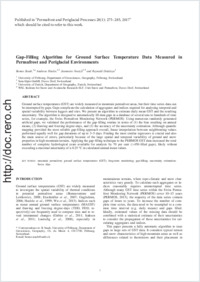Gap‐filling algorithm for ground surface temperature data measured in permafrost and periglacial environments
- Staub, Benno University of Fribourg, Department of Geosciences, Geography, Fribourg, Switzerland
- Hasler, Andreas University of Fribourg, Department of Geosciences, Geography, Fribourg, Switzerland - SensAlpin GmbH, Davos Dorf, Switzerland
- Noetzli, Jeannette University of Zurich, Department of Geography, Zurich, Switzerland - WSL Institute for Snow and Avalanche Research SLF, Unit Snow and Permafrost, Davos Dorf, Switzerland
- Delaloye, Reynald University of Fribourg, Department of Geosciences, Geography, Fribourg, Switzerland
-
01.01.2017
Published in:
- Permafrost and Periglacial Processes. - 2017, vol. 28, no. 1, p. 275–285
mountain permafrost
ground surface temperatures (GST)
long-term monitoring
gap-filling
uncertainty estimation
Swiss Alps
English
Ground surface temperatures (GST) are widely measured in mountain permafrost areas, but their time series data can be interrupted by gaps. Gaps complicate the calculation of aggregates and indices required for analysing temporal and spatial variability between loggers and sites. We present an algorithm to estimate daily mean GST and the resulting uncertainty. The algorithm is designed to automatically fill data gaps in a database of several tens to hundreds of time series, for example, the Swiss Permafrost Monitoring Network (PERMOS). Using numerous randomly generated artificial gaps, we validated the performance of the gap-filling routine in terms of (1) the bias resulting on annual means, (2) thawing and freezing degree-days, and (3) the accuracy of the uncertainty estimation. Although quantile mapping provided the most reliable gap-filling approach overall, linear interpolation between neighbouring values performed equally well for gap durations of up to 3–5 days. Finding the most similar regressors is crucial and also the main source of errors, particularly because of the large spatial and temporal variability of ground and snow properties in high-mountain terrains. Applying the gap-filling technique to the PERMOS GST data increased the total number of complete hydrological years available for analysis by 70 per cent (>450-filled gaps), likely without exceeding a maximal uncertainty of ± 0.25 °C in calculated annual mean values
- Faculty
- Faculté des sciences et de médecine
- Department
- Département de Géosciences
- Language
-
- English
- Classification
- Geology
- License
-
License undefined
- Identifiers
-
- RERO DOC 288638
- DOI 10.1002/ppp.1913
- Persistent URL
- https://folia.unifr.ch/unifr/documents/305416
Other files
Statistics
Document views: 250
File downloads:
- pdf: 256
- gapfilling_functions: 128
- gapfilling_script: 132

